No Customer Left Behind: Why Customer-Centric Business Practices Should Be a Priority for Every CEO
Blog post
Share
This blog was written by Trintech CEO Darren Heffernan and originally appeared on FastCompany.com. It is republished with permission.
In today’s world, those who prioritize the customer are the ones who will define the future.
Whether you’re the CEO of a company or the head coach of a sports team, success hinges on strategy, both in the boardroom and on the field of play. Both arenas require decision-making under pressure and the ability to adapt to changing circumstances—all while keeping a clear vision of the ultimate goal.
For championship teams, this means every player is supported and no effort is wasted. For companies, this means ensuring no customer is left dissatisfied, no detail is overlooked, and no opportunity to improve the customer experience is wasted.
Even the best product or service can fall short if the overall experience falters—like a restaurant with world-class dining but poor service, where word of mouth and bad experiences eventually drive potential customers away. For software-as-a-service (Saas) companies in particular, customer retention isn’t just about solving problems; it’s about anticipating them, streamlining every interaction, and eliminating the obstacles that keep customers from returning.
At Trintech, I’ve spent the past two decades learning this lesson—and over the past two years in the role of CEO, I’ve sharpened my focus, reigniting our passion for putting customers at the center of everything we do.
From Problem Solvers to Trusted Partners
Over the past 20 years, I’ve witnessed a fundamental shift in what it means to deliver exceptional customer experiences. When I started at Trintech, there seemed to be a belief within the SaaS world that it was enough to provide reliable solutions. Now, the bar has been raised to deliver transformative services that not only solve problems but anticipate them. Inspired by our passion for empowering customers, we’ve invested in building a service model rooted in expertise, efficiency, and empathy—helping businesses simplify complexity at scale.
The best approach to service across industries exemplifies a customer-driven philosophy where every engagement is personalized, every solution proactive, and every touchpoint focuses on delivering value.
Consider what makes companies like Chick-fil-A or Marriott so unique—they cater to their clients’ every need, and they do it with a smile on their faces (full disclosure: Chick-Fil-A and Marriott are clients of Trintech). In the world of the financial close, we define success by our ability to become an extension of our customers’ teams, listen to their unique challenges, and deliver the proper tools and guidance.
This customer-centric mindset has helped us build partnerships that stand the test of time and drive measurable outcomes, from improved compliance to faster financial closes. As transformative technologies continue to alter the financial and accounting landscape, all businesses should embrace this approach to remain competitive and deliver meaningful impact in an evolving landscape.
Embracing AI to Drive Better Experience
The financial services sector is at a pivotal moment, driven by rapid advancements in AI technologies that are transforming business operations and customer experiences. At Trintech, we’re leveraging AI to enhance our product offerings and revolutionize how we serve our customers. Our AI-powered finance agents streamline traditionally manual processes in the financial close cycle, automating reconciliations, reducing errors, and providing real-time insights.
Beyond product features, we’re using AI to personalize support, anticipate customer needs, and continuously improve our services. Trintech focuses on balancing customer feedback with innovation, ensuring our AI implementations truly meet our customers’ needs. While we embrace AI, we recognize that the best solutions lie in the balance between automation and strategic human oversight.
This approach enables organizations to work smarter, make more informed decisions, and drive long-term value in an increasingly complex environment. By leveraging AI both within our solutions and in customer interactions, Trintech is not just keeping pace with the AI revolution—we’re leading it while ensuring compliance, risk mitigation, and auditability remain at the core of financial automation.
Seizing the Future
By leveraging this momentum, companies have a unique opportunity to redefine their operations and thrive in a rapidly changing landscape—the companies that serve them also have the chance for significant success if they notice these changes and seize them rapidly.
Customer excellence is not reactive. True service comes with deep expertise and an understanding of the world your client operates within. As companies grapple with the integration of emerging technologies, I believe that it’s the job of service providers to educate and guide them through this critical decision.
The financial services sector is standing at the threshold of a transformative era, and success will depend on a willingness to embrace change, prioritize customer needs, and leverage the power of technology.
At Trintech, we’ve learned that true progress comes from combining deep expertise with a relentless commitment to customer success. Whether it’s simplifying the complexities of the financial close process or guiding companies through critical technology decisions, we’re proud to play a role in helping businesses navigate this evolution.
As new opportunities emerge, the key for every organization will be to stay adaptable and forward-thinking—because in today’s world, those who prioritize the customer are the ones who will define the future.






